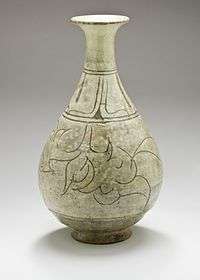Buncheong
| Buncheong | |
|
| |
| Korean name | |
|---|---|
| Hangul | 분청사기 |
| Hanja | 粉靑沙器 |
| Revised Romanization | Buncheong Sagi |
| McCune–Reischauer | Punch'ǒng Sagi |
Buncheong ware, or Punch'ong ware is a form of traditional Korean stoneware, with a bluish-green tone. Pots are coated with a white slip, and decorative designs are painted on using an iron pigment. The style emerged in the early Joseon Dynasty, largely replacing celadon in common use. It all but disappeared from Korea after the 16th century due to the popularity of white porcelains. In modern times, the style has been revived in Korea. Buncheong is characterised by the use of a dark, iron bearing clay, white slip for decoration and a clear glaze. Decorations can be white slip brushed on, drawing through white slip to reveal the dark body, iron oxide pigments applied with a brush and other methods all employing white slip on the dark body.
The Leeum, Samsung Museum of Art in Seoul, houses a permanent collection of Buncheong ware,[1] as well as the National Museum of Korea.
Introduction
Buncheong is a modern term used to describe Korean stoneware produced from the late 14th century and continued today. Buncheong ware developed from inlaid celadon of the earlier Goryeo period in Korea and rapidly distinguished itself. However, through a series of cultural and economic circumstances, Buncheong wares were exported to Japan by practitioners of the Japanese tea ceremony.[2]
After Buncheong wares were adopted by the Japanese tea masters, they started to influence Japanese ceramics. And from Japan, Buncheong spread widely and became known as Mishima pottery. In the 20th century, elements of Buncheong influenced many artists seeking insight into Asian ceramic traditions, and Buncheong continues to inspire artists to this day. Today, some Korean artists are working in stoneware with Buncheong techniques. The development of Buncheong is described in the 2011 book Korean Buncheong Ceramics from Leeum, Samsung Museum of Art, published to accompany the exhibition Poetry in Clay in New York and San Francisco.


See also
References
- ↑ CNN Go Seoul's best museums 27 October 2011. Retrieved 2011-11-04
- ↑ Knapp J. buncheong ceramics. Ceramics Monthly [serial on the Internet]. (2012, Jan), [cited December 2, 2015]; 60(1): 24-25. Available from: Academic Search Complete.
External links
![]() Media related to Punch'ong ware at Wikimedia Commons
Media related to Punch'ong ware at Wikimedia Commons
- Profile of buncheong artist Yoon Kwang-Cho
- Categories of Korean Ceramics
- https://www.britannica.com/art/punchong-pottery

